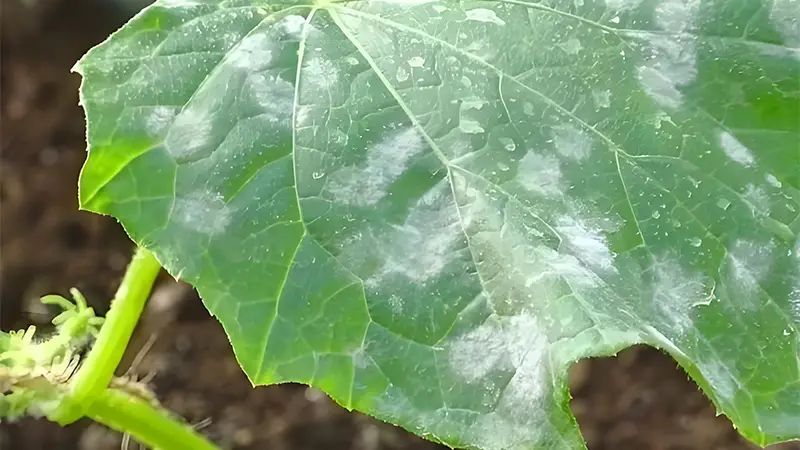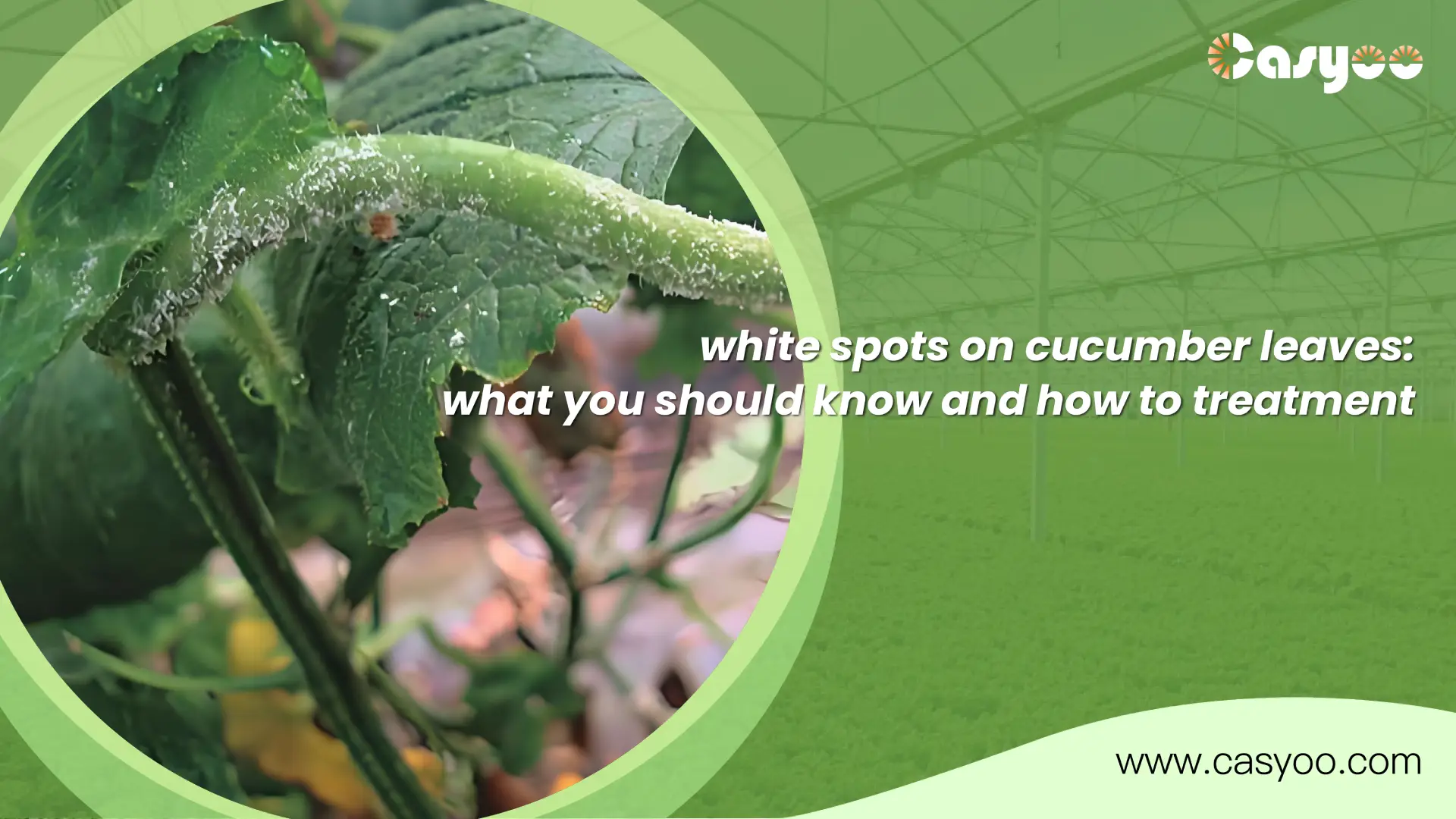Why Are My White Spots on Cucumber Leaves?
There are many reasons why White Spots on Cucumber Leaves, such as powdery mildew, leaf spot disease, and sun burns, among which the main reason is powdery mildew. Powdery mildew is a common disease caused by fungi that host cucumber leaves, and is also easily infected in plants such as gourds, beans, tomatoes, and peppers.
Symptoms to Watch For
Powdery mildew is a common disease of cucumbers. If cucumbers are infected with powdery mildew, it can seriously affect their yield. Understanding the symptoms of cucumber powdery mildew is important for preventing powdery mildew. Below, I will list the symptoms of cucumber powdery mildew:
- Initial Leaf Symptoms
- Small white spots on cucumber leaves
- Appears powder-like or dusty
- Usually starts on older leaves
- Often begins on leaf undersides
- Can appear overnight
- Progressive Development
- Spots enlarge and merge
- White coating becomes thicker
- Spreads to new leaves rapidly
- Can cover entire leaf surface
- Moves to stems and flowers
How Does Powdery Mildew Spread?
Powdery mildew is very easy to spread, and there are various ways of transmission. Let’s take a closer look at the ways powdery mildew spreads.
Wind Dispersal (Main Method)
Wind transmission is the most common and primary mode of transmission for powdery mildew. Powdery mildew is a disease caused by fungi, which produce countless tiny spores while eroding cucumber leaves. These spores are very light, and even a gentle breeze can blow them away to other places. The spores of powdery mildew can spread for tens of meters in the air, allowing it to spread freely in plantations and also affecting other nearby plantations, causing significant losses to all nearby growers. The germination of powdery mildew spores does not require water, and it can easily infect other healthy cucumbers.
Personal Practices
In cucumber plantations, growers often prune the branches and leaves of cucumbers. Some branches and leaves infected with powdery mildew may come into contact with other healthy cucumber leaves when they fall, which can infect those healthy cucumbers. At the same time, the spores of powdery mildew will attach to the clothes, hands, gloves, and tools of the growers, and these spores can survive for a period of time. When the growers are cultivating cucumbers, they will bring these spores to other cucumber leaves, which will also transmit powdery mildew to other cucumbers.
There are still many insects in the cucumber plantation, and the spores of powdery mildew also attach to the insects. When the insects move in the plantation, they will bring the spores to other cucumber leaves, which will also carry the powdery mildew away.
Water transmission
This type of transmission is relatively rare. On rainy days or when watering cucumbers, water flows down from the leaves and carries spores to other leaves.
How to Treat Powdery Mildew on Cucumber?

There are many ways to treat quality cucumber powdery mildew, and I have listed all of them below, hoping that readers can find a suitable treatment method for themselves.
Immediate Cultural Controls
When powdery mildew is found on cucumbers, immediately put the white spots on cucumber leaves into a closed garbage bin and do not use these infected leaves for composting. Build areas with dense leaves, so that different branches and leaves do not come into contact, which will reduce mutual infection between leaves. At the same time, remove the leaves at the roots of the plant, as these leaves may breed spores and cause re infection.
Water Management Strategies
Proper watering is crucial for treating powdery mildew. It is best to water cucumbers in the early morning by sprinkling the water on the soil instead of spraying it on the leaves. Both too dry and too wet can make plants more susceptible to infection.
Natural Baking Soda Solution
By mixing an appropriate amount of baking soda, water, and liquid soap together, it becomes a natural disinfectant. This fungicide will change the pH value on the surface of the leaves, making them unsuitable for fungal growth. In the morning, thoroughly apply this mixture to both sides of the leaves, once a week and after rain. After multiple operations, the powdery mildew bacteria will gradually be killed.
Milk Spray Treatment
Mix milk and water to make a natural fungus carrying spray. The protein in milk produces a preservative substance under sunlight, which inhibits the activity of powdery mildew bacteria. Use this spray twice a week, preferably on a sunny morning, and spray the solution on both sides of cucumber leaves. After sandblasting several times, powdery mildew will gradually disappear. This treatment method is a very healthy and safe way, leaving no harmful residues. When the external light is insufficient, growers need to use plant lights to supplement the light.
Neem Oil Application
Mix an appropriate proportion of neem oil, water, and soap to make an neem oil solution. This solution will disrupt the life cycle of fungi and inhibit their growth and spore secretion. Sandblasting the solution of neem oil onto the surface of cucumber leaves will kill the powdery mildew bacteria on the leaves. Severely infected leaves need to be repeated every 7-14 days.
Chemical pesticide methods
Go to the market and purchase professional pesticides that can kill powdery mildew.
How to Prevent Powdery Mildew?
- Proper Plant Spacing and Location
Maintaining a distance between cucumber plants to prevent them from coming into contact with each other greatly reduces the possibility of cucumber infection, which can effectively reduce powdery mildew on cucumbers. Keeping a distance between cucumbers allows sunlight to fully shine on their leaves while maintaining air circulation. Adequate lighting and ventilation help keep the page dry, which makes it difficult for white powder bacteria to form.
- Watering Practices
When watering cucumbers, do not water them from top to bottom. Instead, directly water the roots of the cucumber. It is best to use drip irrigation with a hose to keep the leaves dry. This environment is not conducive to the growth and development of powdery mildew.
- Garden Sanitation
Maintain the hygiene of the plantation and promptly clean up fallen leaves, which may carry spores of powdery mildew. Timely cleaning of debris in the plantation and timely disinfection can reduce the occurrence of powdery mildew and other diseases.
- Resistant varieties
Planting varieties that carry powdery mildew can naturally inhibit the growth of powdery mildew in cucumbers, greatly reducing the infection of powdery mildew.
Are Affected Cucumbers Safe to Eat?
Plants affected by powdery mildew on cucumbers are safe to consume. The powdery mildew mainly affects the leaves and stems of cucumbers, and the impact on cucumber fruits is relatively small. Cucumbers affected by powdery mildew may look unsightly, but they can be used with confidence.
FAQs
Will powdery mildew kill my cucumber plants?
Although powdery mildew does not immediately kill cucumber plants, it can seriously affect cucumber growth over time. If left untreated, powdery mildew can greatly reduce cucumber yield, hinder cucumber growth, and even lead to cucumber plant death.
How quickly does powdery mildew spread?
In windy conditions, the spread of powdery mildew is very fast. The white powder pathogen can complete its life cycle in just 72 hours, and obvious symptoms will appear within 3-7 days after infection.
Can I prevent powdery mildew by watering differently?
Yes, watering has a significant impact on the development of powdery mildew. Watering the roots of cucumbers in the morning can mainly keep the leaves dry, which is not conducive to the growth of powdery mildew bacteria.
Are organic treatments effective against powdery mildew?
Yes, organic therapy is very effective, especially in the early stages of infection. Solutions such as milk spray, neem oil and baking soda mixture can help control powdery mildew.




